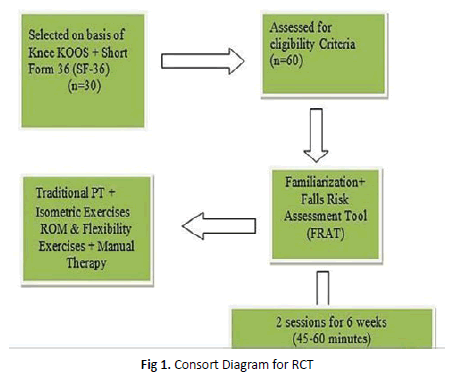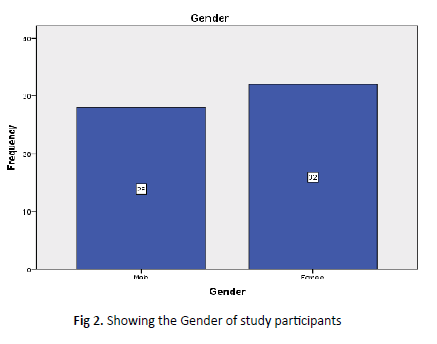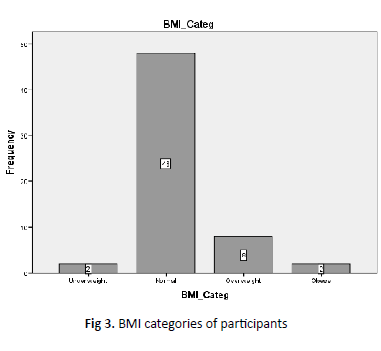Effects of isometric exercises in reducing fall risk in elderly knee osteoarthritis patients
2 Department of Physiotherapy, United College of Physical Therapy, Karachi, Pakistan, Email: rashadabdul66@gmail.com
3 Department of Physiotherapy, Pakistan Institute of Rehabilitation and Medical Sciences, Karachi, Pakistan, Email: abc@gmail.com
4 Department of Physiotherapy, Suleman Roshan College of physiotherapy and Rehabilitation Sciences, Tando Adam, Pakistan, Email: abc@gmail.com
5 Memon College of Physical and Rehabilitative Medicine, Karachi, Pakistan, Email: abc@gmail.com
Received: 21-Mar-2021 Accepted Date: Apr 12, 2021 ; Published: 22-Apr-2021, DOI: 10.37532/1897-2276.2021.16(1).13
This open-access article is distributed under the terms of the Creative Commons Attribution Non-Commercial License (CC BY-NC) (http://creativecommons.org/licenses/by-nc/4.0/), which permits reuse, distribution and reproduction of the article, provided that the original work is properly cited and the reuse is restricted to noncommercial purposes. For commercial reuse, contact reprints@pulsus.com
Abstract
Background: Osteoarthritis is a degenerative joint disease that prompts joint side effects and signs which are related to imperfect joining of articular ligament, related changes in the hidden bones, joint edges, and pain. More than 33.6% affected by age of more than 65 years. This condition is the main reason behind patients' movement restrictions. Most patients cannot perform daliy activities.
Objectives: The objectives of this study were to find out the effects of isometric exercises in reducing fall risk in knee OA in the elderly population and also to find the effectiveness of exercises in improving the quality of life of patients suffering from osteoarthritis.
Materials and Methods: The randomized control consisted of 60 patients. The mean age of participants was 65.28 +-7.8. The Experimental group received isometric exercises while the control group was given routine physical therapy treatment. Data analysis was done using SPSS 20 version. An independent t-test was applied for intergroup comparison. Alpha level 0.05 was considered significant.
Results: The results showed significant improvement in Knee Osteoarthritis Outcome Scale and Fall Risk assessment Tool as p<0.05. KOOS pain score in Experimental vs. Control was (63.1+-11.5 vs 45.7 +-21.1), Stiffness score (61.20+- 10.8 vs 50.0 +- 18.2), Function (59.9 +-12.3 vs 42.0 +-18.2), Sports (53.17+- 14.4 vs 35.7 +-16.3), Quality of life (65.53 +- 12.3 vs. 48.3 +-15.08). Whereas the fall risk assessment tool score was 14.10 +- 00 vs. 13.90 +-41.
Conculsion: The results of the study showed that 6 weeks isometric exercise plan reduces the fall risk in knee Osteoarthritis patients furher it also improves pain and other symptoms related to knee Osteoarthritis
Keywords
knee pain, fall of risk in osteoarthritis, quality of life in osteoarthritis
Introduction
Osteoarthritis is a degenerative joint disease that prompts joint side effects and signs which are related to imperfect joining of articular ligament, related changes in the hidden bones, joint edges, and pain [1]. More than 33.6% affected by age of more than 65 years. This condition is the main reason behind patients’ movement restrictions. Most patients cannot perform daily activities [2, 3]. In OA bone forms at the margins result narrowing in joint space and osteophytosis [4]. OA is the 4th leading cause of disability in the world. It affects women more than men. The prevalence of knee OA in China is 13.6%, India is 5.78%, and Bangladesh is 10.20% [5]. The risk factors associated are obesity, previous knee injury, gender differences [6].
As knee OA causes joint pain, muscle weakness, knee instability, joint deformity, pain, and stiffness. Falls in Knee OA patient is common that leads to many injuries. And those injuries disturb the daily routine of a person and quality of life [7]. Isometric exercises have beneficial effects for patients with knee OA. Isometric quadriceps exercises increase the strength of muscles. Isometric exercises reduce knee pain, improves knee function, stability, and strength [8]. Isometric exercises strengthen the quadriceps muscle, increase joint stability and strength, reduce pain and increase mobility. Thus with isometric exercises patient disability decrease and risk of falls reduce or diminish eventually [9]. Manual home-based exercises also play a role in the treatment of knee OA. Thus isometric exercises are simple and can be easily performed at home. By performing this manual exercise at home too also helps to decreases the risk of fall, pain, and instability [10]. The purpose of this study was to find out the effectiveness of Isometric exercises in reducing the fall risk of elderly knee OA patients. This study will help elder osteoarthritis patients to minimize the fall risk in elderly people. It will help to give detailed information to the patients about knee OA so that they can modify their lifestyle regarding knee OA and we can provide better treatment to the patients.
Methods
This randomized control trial was conducted from January 2020 to August 2020 after the Ethical Approval from Institutional Review Board. The sample was calculated by openEpi tool and a previous study mean was used as a reference [11]. A non-probability convenient sampling technique was used and a total of 60 patients were recruited. With informed consent, data were collected from patients meeting the inclusion and exclusion criteria. Both males and females above 50 years of age with a diagnosis of Osteoarthritis were included in the study. Patients excluded were those with traumatic fracture, ligamentous injury, or knee pain other than osteoarthritis. Randomization was computerized with concealed allocation sequence which was carried out at an external site. Patients were divided into two equal groups. Both groups received two sessions per week for 6 weeks. Patients were evaluated three times, baseline assessment at 1st week, 2nd assessment at 3rd week, and final assessment at 6th week. All the assessments were performed by an independent assessor. The experimental group received Isometric exercises with routine physical therapy treatment. While the control group received routine physical therapy treatment which included Manual therapy, ultrasound, TENS, and hot pack. The duration of the session was 60 minutes. Data analysis was done by SPPS 20. An independent t-test was used for intergroup comparison. Knee Osteoarthritis Outcome Scale (KOOS) and Fall Risk Assessment Tool (FRAT) were used as an outcome measure. p<0.05 was considered significant.
Results
The mean was 65.28 ± 7.8. Out of the total of 60 subjects, 32 were female while 28 were male (Figure 2). The BMI categories showed that 48 individuals were with normal BMI, 2 with underweight, 8 overweight, while 2 were obese (Figure 3). KOOS scores with mean ± SD are shown in Table 2. FRAT scores with mean ± SD are presented in Table 3. The results showed significant differences between the experimental and control group as p<0.05.
| GROUP A (CONTROL GROUP) | GROUP B (EXPERIMENTAL GROUP) | ||
|---|---|---|---|
| History | 05 Mints | History | 05 Mints |
| Assessment | 10 Mints | Assessment | 10 Mints |
| TREATMENT | |||
| Hot Pack | 10 Mints | Hot Pack | 10 Mints |
| TENS | 10 Mints | TENS | 10 Mints |
| ROM & Flexibility Exercises | 10 Mints | Isometric Exercises ROM and Flexibility Exercises | 10 Mints |
| Manual Therapy | 10 Mints | Manual Therapy | 10 Mints |
| Ultrasound Therapy | 5 Mints | Ultrasound Therapy | 5 Mints |
Table 1. Treatment protocol for both groups.
| Knee Osteoarthritis Outcome Scale(KOOS) | Assessments | Control Group (Mean ± SD) |
Experimental Group (Mean ± SD) |
p value |
|---|---|---|---|---|
| Pain | 0 week | 23.24 ± 18.80 | 26.20 ± 16.99 | 0.524 |
| 3rd week | 42.53 ± 17.9 | 58.20 ± 14.7 | 0 | |
| 6thweek | 45.77 ± 21.1 | 63.10 ± 11.5 | 0 | |
| Stiffness | 0 week | 19.05 ± 17.4 | 26.43 ± 17.6 | 0.108 |
| 3rd week | 46.43 ± 16.4 | 58.33 ± 11.3 | 0.002 | |
| 6thweek | 50.00 ± 18.2 | 61.20 ± 10.8 | 0.005 | |
| Function | 0 week | 22.06 ± 17.9 | 27.06 ± 15.5 | 0.253 |
| 3rd week | 37.30 ± 17.8 | 54.27 ± 13.8 | 0 | |
| 6thweek | 42.00 ± 18.2 | 59.93 ± 12.3 | 0 | |
| Sports | 0 week | 22.67 ± 18.6 | 25.67 ± 15.9 | 0.506 |
| 3rd week | 31.60 ± 14.1 | 47.50 ± 15.7 | 0 | |
| 6thweek | 35.77 ± 16.3 | 53.17 ± 14.4 | 0 | |
| QOL | 0 week | 20.63 ± 18.5 | 25.21 ± 19.31 | 0.353 |
| 3rd week | 43.70 ± 13.2 | 61.90 ± 12.4 | 0 | |
| 6thweek | 48.33 ± 15.08 | 65.53 ± 12.3 | 0 |
Table 2. KOOS Scores of Group A and Group B.
| Assessments | Control Group (Mean ± SD) |
Experimental Group (Mean ± SD) |
p value |
|---|---|---|---|
| 0 week | 12.53 ± 1.5 | 12 .37 ± 1.2 | 0.653 |
| 3rd week | 13.90 ± 0.41 | 14.10 ± 0.00 | 0.009 |
| 6thweek | 13.90 ± 0.41 | 14.10 ± 0.00 | 0.009 |
Table 3. Fall Risk Assessment Tool score.
Discussion
This study had 60 participants. The mean age of subjects was 65.28 ± 7.8. In this study, Group B was an experimental group and was given Isometric Exercises and ROM and stretching of the knee and Group A was given only ROM and stretching exercises of the knee. The KOOS section of the pain Experimental Group showed more significant results as compared to the Control Group with a significant p-value <0.05 (63.1 ± 11.5 vs. 45.7 ± 21.1),. In stiffness section of the KOOS Experimental Group showed more significant results as compared to the Control Group (61.20 ± 10.8 vs. 50.0 ± 18.2) p<0.05. In ADL’s Experimental Group also showed more significant results as compared to the Control Group (59.9 ± 12.3 vs. 42.0 ± 18.2) p<0.05. In Sports/ Rec Experimental Group showed more significant results as compared to the Control Group (53.17 ± 14.4 vs. 35.7 ± 16.3) p<0.05. In Quality of Life, the Experimental Group showed more significant results as compared to the Control Group with a significant p-value<0.05 (65.53 ± 12.3 vs. 48.3 ± 15.08). Assessment Tool scores were 14.10 ± 00 vs. 13.90 ± 41.
Riann M. Palmieri-Smith et al., conducted a study to determine that quadriceps strength decreases as osteoarthritis severity increases. Results showed that quadriceps strength (Nm/kg) was 22% greater in women without radiographic osteoarthritis than in women with osteoarthritis (p<0.05). Quadriceps strength was also greater in women with Noyes’ medial tibial and femoral cartilage scores of 0 when compared in women with Noyes’ grades 2 and 3-5 (p ≤ 0.05). This study supports the results of our study that knee isometrics reduces the complications of knee osteoarthritis [12].
A study by Lucie Brosseauet aimed to find the effects of knee isometrics in knee osteoarthritis. Results of the study showed that knee isometrics and strengthening exercises program helps to relieve pain in knee osteoarthritis, p-value<0.05. This study supports the results of our study as knee isometrics helps to reduce the pain in knee osteoarthritis and also improves muscle strength [13]. FatihToket al. conducted a study to evaluate the effects of electrical stimulation combined with Continuous Passive Motion (CPM-ES) versus isometric exercise on symptoms, functional capacity, quality of life, muscle strength, knee and thigh circle measurements, and balance in knee Osteoarthritis (OA). Results of this study showed that knee isometrics can reduce the pain in knee osteoarthritis and also improves the strength of muscles. This is also in accordance with the results of our study [14].
A study conducted by Rana S Hinmaniet et al. aimed to evaluate the effects of strengthening exercise in knee OA. The intervention resulted in less pain and joint stiffness and greater physical function, quality of life, and hip muscle strength. Totals of 72% and 75% of participants reported improvements in pain and function, respectively, compared with only 17% (each) of control participants. Benefits were maintained 6 weeks after the completion of physical therapy, with 84% of participants continuing independently. This study also complies with the results of our study [15].
Lanfeng Huang and his colleagues conducted a study in 2017 and their results showed that knee isometric exercises improve knee pain and quality of life in patients suffering from knee OA. The results of this study are in accordance with the current study [16].
Conclusion
This study concluded that 6 weeks isometric exercise plan helps to improve the strength of the Knee joint in osteoarthritis patients. Isometric exercises also show significant improvement in pain, quality of life and reduce the risk of falls in elderly patients.
Limitations
The sample size was small and treatment duration was less, so longterm improvement in functional disability was not observed.
Recommendations
• In further studies, data should be taken based on gender-based differences in physical activity level.
• Treatment duration should be increased to observe the long-term effects on functional disability.
• The sample size should be large so that results can be generalized over the whole population.
REFERENCES
- Iqbal M.N., Haidri F.R., Motiani B., et al.: Frequency of factors associated with knee osteoarthritis. J Pak Med Ass. 2011;61:786.
- Ringdahl E.N., Pandit S.: Treatment of knee osteoarthritis. Amer Fam Phy. 2011;83:1287-1292.
- Fernandes L., Hagen K.B., Bijlsma J.W., et al.: EULAR recommendations for the non-pharmacological core management of hip and knee osteoarthritis. Annals Rheumatic Dis. 2013;72:1125-1135.
- Esser S., Bailey A.: Effects of exercise and physical activity on knee osteoarthritis. Curr Pain Headache Rep. 2011;15:423-430.
- Fransen M., Bridgett L., March L., et al.: The epidemiology of osteoarthritis in Asia. Int J Rheumatic Dis. 2011;14:113-121.
- Blagojevic M., Jinks C., Jeffery A., et al.: Risk factors for onset of osteoarthritis of the knee in older adults: a systematic review and meta-analysis. Osteoarthritis Cartilage. 20101;18:24-33.
- Levinger P., Menz H.B., Wee E., et al.: Physiological risk factors for falls in people with knee osteoarthritis before and early after knee replacement surgery. Knee Sur Sports Traumatol Arthro. 2011;19:1082-1089.
- Anwer S., Alghadir A.: Effect of isometric quadriceps exercise on muscle strength, pain, and function in patients with knee osteoarthritis: a randomized controlled study. J Phy Ther Sci. 2014;26:745-748.
- Choi Y.L., Kim B.K., Hwang Y.P., et al.: Effects of isometric exercise using biofeedback on maximum voluntary isometric contraction, pain, and muscle thickness in patients with knee osteoarthritis. J Phy Therapy Sci. 2015;27:149-153.
- Carvalho N.A., Bittar S.T., Pinto F.R., et al.; Manual for guided home exercises for osteoarthritis of the knee. Clinics. 2010;65:775-780.
- Khalaj N., Osman N.A., Mokhtar A.H., et al.: Balance and risk of fall in individuals with bilateral mild and moderate knee osteoarthritis. PloS one. 2014;9:e92270.
- Palmieri-Smith R.M., Thomas A.C., Karvonen-Gutierrez C., et al.: Isometric quadriceps strength in women with mild, moderate, and severe knee osteoarthritis. Am J Phy Med Rehabil/Ass Acad Physiatrists. 2010;89:541.
- Brosseau L., Taki J., Desjardins B., et al.: The Ottawa panel clinical practice guidelines for the management of knee osteoarthritis. Part two: strengthening exercise programs. Clin Rehabil. 2017;31:596-611.
- Tok F., Aydemir K., Peker F., et al.: The effects of electrical stimulation combined with continuous passive motion versus isometric exercise on symptoms, functional capacity, quality of life and balance in knee osteoarthritis: Randomized clinical trial. Rheumatol Int. 2011;31:177-181.
- Hinman R.S., Heywood S.E., Day A.R.: Aquatic physical therapy for hip and knee osteoarthritis: results of a single-blind randomized controlled trial. Phy Ther. 2007;87:32-43.
- Huang L., Guo B., Xu F., et al.: Effects of quadriceps functional exercise with isometric contraction in the treatment of knee osteoarthritis. Int J Rheumatic Dis. 2018;21:952-929.






 Journal of Orthopaedics Trauma Surgery and Related Research a publication of Polish Society, is a peer-reviewed online journal with quaterly print on demand compilation of issues published.
Journal of Orthopaedics Trauma Surgery and Related Research a publication of Polish Society, is a peer-reviewed online journal with quaterly print on demand compilation of issues published.